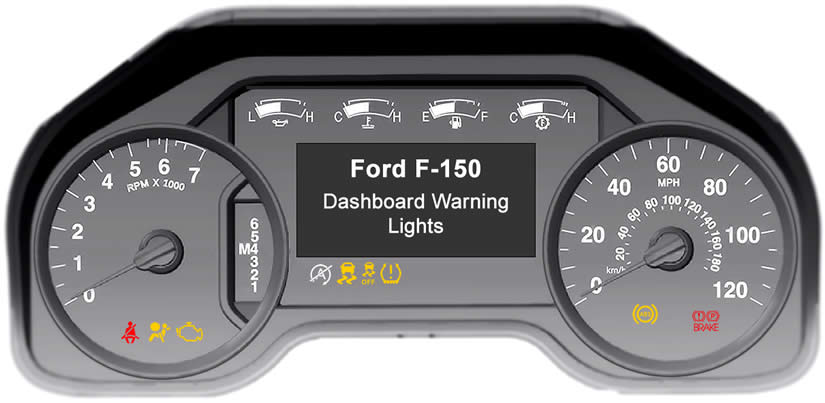Ford F150 Dashboard Warning Lights
Here we have the dashboard warning lights for the Ford F-150 pickup truck, twelfth generation (2009 – 2014) and thirteenth generation (2015 – present). Dashboard display layout and warning light location may vary depending on your model.
Many of the Ford F-150 warning lights illuminate briefly when the vehicle engine is started either as a bulb check or system check. If a warning light remains on, it’s recommended that immediate action is taken as this may help to avoid expensive repairs. Depending on your model of F-150, certain warning lights are reconfigurable telltale (RTT) indicators. Rather than having a dedicated bulb, RTT warnings are displayed in the information message center, but function the same as a warning light.
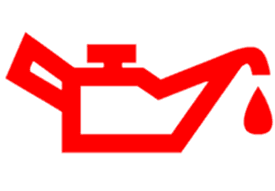
Ford F-150 oil pressure warning light
The oil pressure warning may be displayed via a gauge and/or a warning light. If the warning light illuminates or the gauge needle falls below normal operating range, stop the vehicle as soon as possible and switch off the engine. After allowing a few minutes for the oil to settle into the pan, check levels and top up if required. Only continue driving if the oil light goes off. If it remains on even after adding oil, severe engine damage may occur if the vehicle is driven.
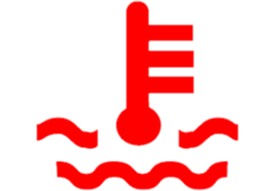
Ford F-150 engine coolant warning light
The red engine coolant warning may be displayed via a gauge and/or a warning light. If the engine coolant gauge needle exceeds the normal range, or the warning light illuminates, stop the vehicle as soon as possible and allow to cool. Check coolant levels are sufficient cooling has taken place. Top up if required and check for leaks. The check engine warning light may also illuminate.

Ford F-150 low fuel warning light
The low fuel warning reminder triggers when the fuel gauge needle is at 1/16th or about 35 miles (56 km) before the tank is empty, whichever occurs first.
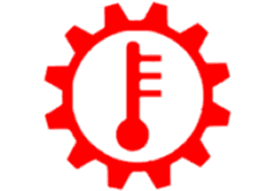
Ford F-150 transmission temperature warning light
In the Ford F-150, the transmission temperature warning may be displayed via a gauge and/or a warning light. If the warning light comes on or the gauge exceeds normal operating range, stop your vehicle as soon as possible and ensure airflow to the front grill is not obscured. The high temperature range may also be associated with high engine loads such as towing. Continued driving with the transmission in the high temperature range may cause damage. Alter the severity of your driving conditions to lower the transmission temperature into the normal range.
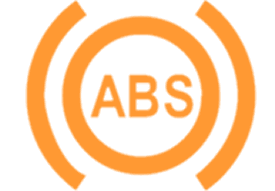
Ford F-150 ABS warning light
The ABS warning light illuminating or flashing indicates a failure of the anti-lock braking system. Normal brake will continue to operate as normal, but without ABS. You can continue to drive the vehicle with caution. Check ABS sensors, wiring and fuses.
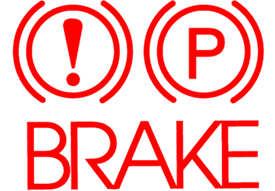
Ford F-150 brake warning light
The brake warning light may illuminate for the following reasons:
1. The hand brake is not fully released.
2. Brake fluid levels are low.
3. A fault in the brake system.
The ABS warning light may illuminate along with the brake light.

Ford F-150 battery warning light
The battery warning light remains on when the battery is not being charged properly. In the event of a discharged battery, then engine will shut down. If driving, immediately switch off any unnecessary electrical equipment and make your way to a auto repair workshop. An ageing, failing battery may be at fault, the alternator or lose, damaged cables.

Ford F-150 wrench warning light
The Ford F-150 wrench warning light means there’s a powertrain or an all-wheel drive fault. Typical messages that display along with the wrench warning light are ‘Check 4×4‘ and ‘Electronic Throttle Control‘. Due to the many potential issues, you’ll be required to use a diagnostic code reader to plug into your OBD II port and obtain a fault code. If a fault code has been generated and stored, it will help with locating the fault. Vehicle may enter reduced engine power mode.

Ford F-150 blind spot monitor warning light
The Ford F-150 blind spot monitor uses radar sensors that are located behind the bumper fascia on each
side of your vehicle. If you are having issues with the blind spot monitoring system, it’s possible that dirt, mud or snow is in front of the sensors causing the fault. If your vehicle has received an impact to the sensor area, it can also affect system performance.

Check engine warning light
The Ford F-150 check engine warning light, also known as the ‘service engine soon’ light comes on because the On Board Diagnostics system (OBD) has detected a fault in the emissions system. The check engine warning light will typically remain illuminated or flash. In general, you can continue driving with the warning light illuminated, though it’s advised to have the fault rectified as soon as possible to avoid engine damage. If the light is flashing, it may mean an engine misfire is occurring.
This can potentially cause catalytic converter damage due to excessive heat. Immediately reduce speed and if towing a heavy load, if possible reduce weight. It’s only possible to diagnose the fault by using a diagnostic code reader and plug into your OBD II port to obtain a fault codes. The check engine warning light can come on due to a lose gas cap, so this is the easiest to first check. Other common faults can include: oxygen sensor, mass airflow sensor, spark plug issues.

Ford F-150 stability / traction control warning light
This warning light may stay on constantly to indicate a fault. In this instance, the fault may be due to the ABS wheel speed sensors. If the stability / traction warning light flashes, it means the system is operating and attempting to stabilize the vehicle.
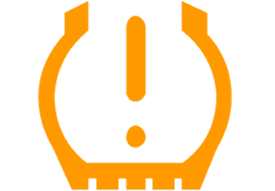
Ford F-150 tire pressure warning light
The Ford F-150 uses a ‘direct’ tire pressure monitoring system (TPMS) meaning that a pressure sensor is mounted inside each wheel. If the warning light stays on constantly, it means one or more tires is under-inflated, or that tire rotation has been completed without sensor training. If the warning light flashes, it means there’s a fault with the TPMS, vehicle security module (this receives the radio frequency from the sensor), a faulty sensor, a sensor battery has expired, or a tire has been fitted that does not contain a sensor.
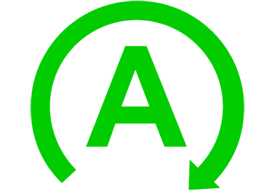
Ford F-150 auto start-stop warning light
Auto engine stat-stop is intended to improve economy and reduce harmful exhaust emission. Auto start-stop is on by default by each ignition cycle. It can only be permanently switched off by using third party accessories.

Airbag warning light
The Ford F-150 airbag warning light should come on briefly when the engine has started and then go off. If the warning light fails to illuminate or comes on or flashes while driving, it indicates a fault. Airbags are unlikely to be deployed in the event of a collision and on rare occasions, they may activate unexpectedly.

Ford F-150 O/D OFF warning light
O/D stands for overdrive and it’s essentially an extended gear used for the purposes of fuel economy. Generally you’ll want to leave overdrive on, especially on long runs where is may help to save fuel. Instances where you may wish to turn it off are going down a gradient as engine braking of a lower gear will help to control vehicle speed. You my also wish to turn overdrive off where greater engine power is required, for example towing a heavy load or overtaking. If the O/D OFF light is flashing, it indicates a fault with the transmission.
